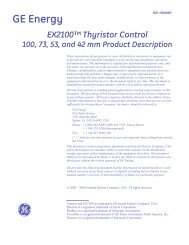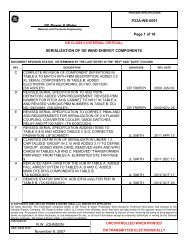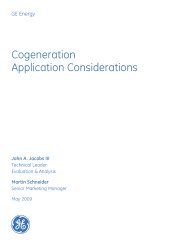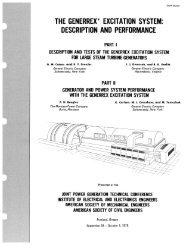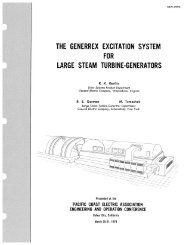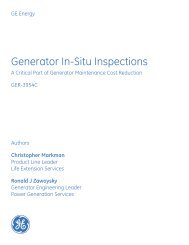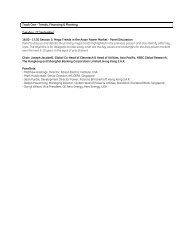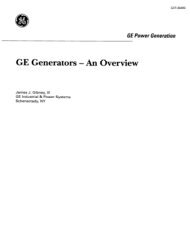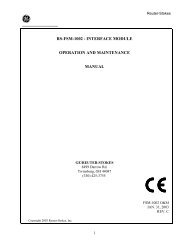GER 3568G - Dry Low NOx Combustion Systems for ... - GE Energy
GER 3568G - Dry Low NOx Combustion Systems for ... - GE Energy
GER 3568G - Dry Low NOx Combustion Systems for ... - GE Energy
Create successful ePaper yourself
Turn your PDF publications into a flip-book with our unique Google optimized e-Paper software.
<strong>Dry</strong> <strong>Low</strong> NO x <strong>Combustion</strong> <strong>Systems</strong> <strong>for</strong> <strong>GE</strong> Heavy-Duty Gas Turbines<br />
ference in <strong>NOx</strong> emissions can be expected if<br />
reaction zone equivalence ratio, water injection<br />
rate are equal.<br />
As shown in Figure A-3, the rate of <strong>NOx</strong> production<br />
dramatically decreases as flame temperature<br />
decreases (i.e., the flame becomes fuel<br />
lean). This is because of the exponential effect<br />
of temperature in the Zeldovich Mechanism<br />
and is the reason why diluent injection (usually<br />
water or steam) into a gas turbine combustor<br />
flame zone reduces <strong>NOx</strong> emissions. For the<br />
same reason, very lean dry combustors can be<br />
used to control emissions. Lean, dry control is<br />
desirable <strong>for</strong> reaching the lower <strong>NOx</strong> levels now<br />
required in many applications, and also to avoid<br />
the turbine efficiency penalty associated with<br />
diluent injection.<br />
Figure A-3. NO x production rate<br />
There are two design challenges associated with<br />
very lean combustors. First, care must be taken<br />
to ensure that the flame is stable at the design<br />
operating point. Second, a turndown capability<br />
is necessary since a gas turbine must ignite,<br />
accelerate, and operate over the load range.<br />
Both of these challenges are driven by the need<br />
to operate the combustor at low flame temperatures<br />
to achieve very low emissions. There<strong>for</strong>e<br />
the combustor operating point at full load is<br />
just above the flame blowout point, which is the<br />
point at which a premixed fuel and air mixture<br />
is unable to self sustain. At lower loads, as fuel<br />
flow to the combustors decreases, the flame<br />
temperature will approach the blowout point<br />
and at some point the flame will either become<br />
unstable or blow out. This behavior is in direct<br />
contrast to that of a diffusion flame combustor.<br />
In that type of combustor the fuel is injected<br />
unmixed and burns at maximum flame temperature<br />
using only a portion of the available air.<br />
This results in high <strong>NOx</strong> emissions, but has the<br />
benefit of very good stability because the flame<br />
burns at the same temperature independent of<br />
fuel flow.<br />
In response to these challenges, combustion system<br />
designers use staged combustors so a portion<br />
of the flame zone air can mix with the fuel<br />
at lower loads or during startup. The two types<br />
of staged combustors are fuel-staged and airstaged<br />
(Figure A-4). In its simplest and most<br />
common configuration, a fuel-staged combustor<br />
has two flame zones; each receives a constant<br />
fraction of the combustor airflow. Fuel<br />
flow is divided between the two zones so that at<br />
each machine operating condition, the amount<br />
of fuel fed to a stage matches the amount of air<br />
available. An air-staged combustor uses a mechanism<br />
<strong>for</strong> diverting a fraction of the airflow<br />
from the flame zone to the dilution zone at low<br />
<strong>GE</strong> Power <strong>Systems</strong> ■ <strong><strong>GE</strong>R</strong>-<strong>3568G</strong> ■ (10/00) 19<br />
Primary<br />
Stage<br />
Primary Stage<br />
Secondary<br />
Stage<br />
Dilution<br />
Zone<br />
Dilution<br />
Zone<br />
Figure A-4. Staged combustors



